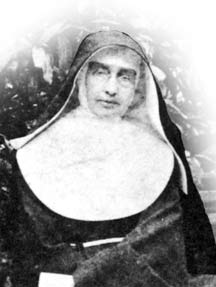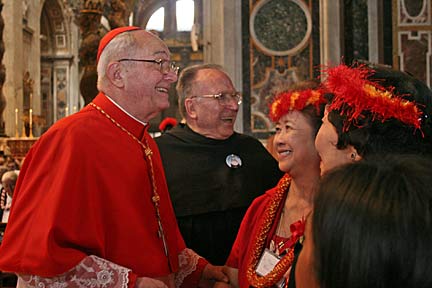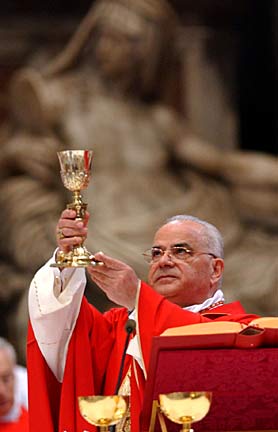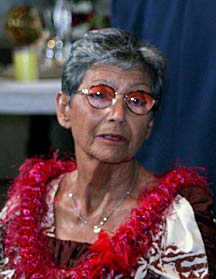OF MOTHER MARIANNE COPE

Sister Frances Therese Souza, front left, a nurse at Kalaupapa, waved a scarf alongside Sister Davilyn Ah Chick of Oahu yesterday at the end of a Mass and a beatification ceremony for Mother Marianne Cope at St. Peter's Basilica in Vatican City. Both Cope and Spanish nun Ascension del Corazon de Jesus were declared "blessed."
‘Blessed’
Mother Cope
The Kalaupapa nun reaches
the second step to sainthood
She's beyond just a Kalaupapa icon now, and more than the Franciscan Sisters' role model.
![]()

Cope's decision to serve leprosy victims in Hawaii "was a wonderful work of divine grace," said Cardinal Jose Saraiva Martins, who presided at the beatification celebration in St. Peter's Basilica in Vatican City yesterday. "She saw in them the suffering face of Jesus Christ."
Muumuus and leis worn by some Hawaii pilgrims fit the cosmopolitan character of the crowd of nearly 2,000 people, the majority of whom were fans of a Spanish nun who was beatified along with Cope. People in the national costumes of several countries touched by Mother Ascension del Corazon de Jesus paraded forward with gifts at the offertory. Scriptural readings and prayers were done in Spanish and English to reflect the two honorees.
The cardinal praised Blessed Ascension, founder of the Dominican Missionaries of the Rosary, as "one of the greatest missionaries of the past century." She died in 1940.
"It was thrilling just to be in that setting, under the chair of St. Peter, with the artwork and the history," said Patrick Downes, who represented the Honolulu diocese. He and Sister Patricia Burkhard, head of the Syracuse, N.Y.-based Sisters of St. Francis, presented a set of vestments among gifts that also included a maile lei given to Martins by Norman Nakamoto of the Royal Order of Kamehameha.
"Hearing 'Makalapua' sung there was chicken skin," Downes said. The song that was Cope's favorite was sung before the Mass by a choir of the Hawaii and Syracuse pilgrims.
They stood near the Sistine Chapel choir, who "sounded just perfect, like you see on TV," said choir member Agatha Leighnor of Pearl City. "We never thought we'd sound that way, but I felt we did. It was just awesome. I would never have thought it could have happen, yet I was part of that." She said the singers had an unplanned dress rehearsal Friday while on tour in St. Francis' hometown of Assisi. A priest arranged a mass for them in St. Francis Basilica, and the choir sang the peace prayer of St. Francis and "How Great Thou Art" in Hawaiian.

From left, Cardinal Agostino Cacciavillan, postulator for the cause of Mother Marianne Cope; Franciscan Father Ernestino Piacentini; Sister of St. Francis Marie Jose Romano; and Dr. Celina Guerrero talked in St. Peter's Basilica, Vatican City, yesterday prior to Cope's beatification ceremony.
Cardinal Jose Saraiva Martins celebrated a Mass inside St. Peter's Basilica at the Vatican yesterday during the beatification ceremony of Mother Marianne Cope.
As the crowd filed out of the basilica, the Franciscan sisters "went back to where they had unveiled the banner," Dillenschneider said. "Her sisters sang that song, 'Makalapua,' to her again. Then we came home and had a celebration at the hotel."
Daisy Galura of Aiea said: "The ceremony was very inspiring. It uplifted us to look at them and how they lived their life to follow Christ. It motivates us to be like them. Even though we cannot accomplish what they did, we can improve ourselves day to day."
The excitement isn't over for the travelers to Rome. They have an audience with Pope Benedict XVI tomorrow.
The sainthood cause for Blessed Marianne was launched in 1983, spearheaded by Sister Mary Laurence Hanley of Syracuse, a retired teacher. Hanley and the late O. A. "Ozzy" Bushnell co-authored a Cope biography, "The Song of Pilgrimage and Exile," which they presented to Pope John Paul II that year.
After perusing volumes of material on her life, Vatican theologians found Cope to be of "heroic virtue" and she was declared "venerable" in April 2004, the first of three steps to sainthood.
For the next step, theologians must confirm that the candidate posthumously brought about a miracle. Vatican officials in December accepted a 1992 medical cure as the miracle. It involved a 14-year-old New York girl who recovered from multiple organ failure after friends and family prayed for Cope's intercession and a bookmark on which Cope had written "Sweet Jesus Mercy" was held to her forehead.
A second miracle must be verified before any candidate is eligible to be declared a saint.
By turning the beatification ceremony over to Martins, head of the Congregation for the Causes of Saints, Pope Benedict signaled a return to a past tradition. Only since 1971 have popes gotten involved in beatifications. Pope Benedict will preside only at the final step of canonization.
Nun from Germany
answered isles’
call for help
Mother Marianne Cope was born Jan. 23, 1838, in Germany to Peter and Barbara Koob, who immigrated to the United States when she was 1 year old.
After entering the Sisters of St. Francis in 1862, she rose through nursing and administrative positions to become head administrator of St. Joseph's Hospital in Syracuse, N.Y., and provincial of her religious community.
Cope arrived in Hawaii on Nov. 8, 1883, bringing six other nuns in response to a call for help from the Kingdom of Hawaii and local church officials. She administered a Kakaako facility for leprosy victims, and opened a home for the children of patients on Oahu and a hospital on Maui.
In November 1888, Cope took nursing sisters to Kalaupapa, just five months before the death of Father Damien DeVeuster from the disease. They operated the infirmary, and opened a home for unprotected women and girls and, eventually, a home for boys.
Cope died Aug. 9, 1918, at 80 years of age and was buried on the grounds of the Bishop Home for girls.
Kalaupapa patient
shares in nun’s honor
When Mother Marianne Cope was declared "blessed," Kalaupapa resident Winnie Marks Harada was there to applaud.
![]()

![]()
Winnie Harada: She carried a bouquet in the ceremony
Harada had a role in the beatification ceremony. She carried a floral bouquet, accompanying Sister Davilyn Ah Chick, who brought forward a reliquary box containing soil and bone fragments from Cope's gravesite as a large banner of the 19th-century nun was unfurled.
Harada, who was sent to Kalaupapa in 1943 as a teenager, is reluctant to be identified as a representative of the place. But she knows she'll be a messenger to the folks back home. "The patients will want to know everything that happens," she said. Harada was one of several former patients who attended the beatification of Father Damien DeVeuster in Brussels in 1995.
Winnie and Paul Harada, who recently celebrated their 50th wedding anniversary, are among about 30 former Hansen's disease patients who still choose to live in Kalaupapa.
The quarantine was lifted in 1969 after drugs were developed to treat the disease. About 40 people who contracted the disease before the medicine was used are still alive. Their average age is 76, and the state is committed to providing them lifelong care.
Nearly 8,000 people were banished to Kalaupapa over the span of a century.
There are more than that number of Hansen's disease patients living in Hawaii today, according to the state Department of Health. A 2002 department census counted about 10,000 diagnosed here, many of whom are immigrants from the South Pacific.
[News] [Business] [Features] [Sports] [Editorial] [Do It Electric!]
[Classified Ads] [Search] [Subscribe] [Info] [Letter to Editor]
[Feedback]
